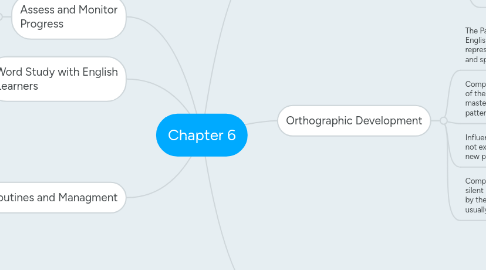
1. Literacy Development in Within Word Pattern Stage
1.1. Reading:Students move from full alphabetic phase to consolidated alphabetic phase and move from oral reading to periods of SSR.
1.2. Writing: Becomes more fluent because students take less time on spelling, etc and are able to concentrate on ideas.
1.3. Vocab: Students can add 10-15 new words a week on average. Teachers must be active and deliberate in vocab instruction
1.3.1. Use word sorts, read alouds, concept sorts, dictionaries and simple prefixes and suffixes to build vocab.
2. Orthographic Development
2.1. The Pattern Principle: Students begin to explore the patterns of English spelling. They choose from a variety of patterns that represent the same phonemes. They learn about silent vowels and special consonant patterns.
2.2. Complexities of English Vowels: Vowel patterns dominate much of the word study during the pattern phase. Students typically master short vowel sounds first then move on to more complex patterns
2.3. Influence of Consonants on Vowels: These are not exceptions to the vowel rules, but are rather new patterns that need to be learned.
2.4. Complex Consonants Patterns: Triple blends like spr- or -tch, silent "e" and consonants that have sounds that are determined by the vowel that follows, kn- blends wr- blends, etc. These are usually studied toward the end of the phase.
3. Word Study Instruction for the Within Word Pattern Stage: Carefully planned word sorts are a systematic way to master the complexities of vowel and consonant patterns.
3.1. Word Sorts often begin as teacher directed and then offer individual practice and follow a standard format. Demonstrate the sort. Students work individually or with a partner to sort and check the words. Reflect on why they sorted words a certain way. Extend the independent work throughout the week.
3.1.1. Picture Sorts may benefit kids who have problems distinguishing between short and long vowels. They develop phonemic awareness and focus attention on the sound without the printed word.
3.1.2. Teacher Directed 2 step sort for long vowels: starts with sounds and moves to patterns. Use words with long and short vowels sounds and some oddball words. Discuss the categories and model how to sort. Then have students sort independantly.
3.1.3. Open Sorts: Have students brainstorm ways to sort then cone to an agreement on how to sort, either sounds, patterns or both. Agree on key words with students and ask them to all sort the same way.
4. Assess and Monitor Progress
4.1. By the end of 2nd grade should be in the middle of the word pattern stage or beyond.
4.1.1. Use weekly spelling tests and blind sorts to assess
4.1.1.1. Use Period unit assessments to make sure they retain .
